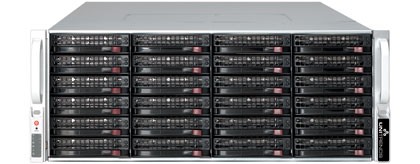Unitrends Recovery-943: The Soul of a New Backup Appliance

Unitrends recently introduced the Unitrends Recovery-943. This appliance is the next generation flagship of the Unitrends Recovery-series of backup appliances. The Recovery-943 represents revolutionary advances in engineering, technology, design, and performance. It transcends the backup appliance category and represents the epitome of balanced performance, density, and affordability. With a full suite of integrated data protection software, 40 drives delivered in a high-density 4U chassis arranged in a three-tiered storage architecture coupled with 256GB of memory and 32 processor threads, the raw capabilities and performance of the Recovery-943 are unlike any backup appliance on the market today. In this series of blog posts we’ll first discuss why backup appliances are experiencing such rapid demand and adoption. We’ll then explore the challenges that enterprise-class data protection backup appliance vendors face. After that we’ll briefly discuss the architecture of the Recovery-943 and then we’ll explore the way that the Recovery-943 designers responded to each of the aforementioned challenges.
WHY BACKUP APPLIANCES?
Backup appliances exist to lower the TCO (Total Cost of Ownership) associated with the data protection of an IT environment. Backup appliances were initially designed almost exclusively for small and medium enterprises that couldn’t afford to have backup specialists on staff who spent all their time integrating, maintaining, upgrading, and adjusting the server, storage, I/O, networking, operating system software, antivirus software, backup software, archiving software, replication software, and the like that constitutes a backup solution.
Backup software vendors in essence pushed the design and implementation of backup solution integration to their customers. This had the effect of increasing the software vendors’ profits since this shift of capital and operational expense was transferred from the backup software vendor to the buyer. Backup appliances were created to directly address this by reducing this capital and operational expense burden from the buyer back to the backup appliance vendor.
At the same time, backup appliance engineering and technology has significantly changed over the years. Ten years ago, backup appliances were relatively simple devices that basically just bundled all of the components listed above into a relatively simple integrated hardware and software package. As data protection grew more complex and began including not only file backup but block backup, dissimilar bare metal, virtual environment backup, archiving, and replication for disaster recovery, and other features the design of the backup appliance grew more complex.
The Adoption of Deduplication
With the advent of deduplication, a new class of companies sprung up in order to enable IT staff to lower its TCO by creating a dedicated deduplication storage appliance that could handle the often unpredictable demands of deduplication separately from the demands of backup, archiving, replication, and other data protection functionality. Eventually backup software vendors began integrating deduplication into the backup software itself. The trouble was (and is) that this made the integration and maintenance of data protection much more complex because the server, storage, I/O, and networking had to be carefully balanced to optimize deduplication with all other data protection functionality.
This dramatic increase in complexity has increased the desire for backup appliances since the task balancing server, storage, I/O, and networking performance with deduplication is the backup appliance vendor’s responsibility rather than the buyer’s responsibility.
Virtualization Failover
A more recent advance in data protection is virtualization failover, which is more often termed by a derivation of the term “instant recovery.” There are two forms of virtualization failover: on-host and off-host virtualization failover. In on-host virtualization failover, a backup is executed as a virtual machine entirely using the resources associated with the server and storage upon which the backup software executes. Off-host virtualization failover is similar except the backup is executed as a virtual machine using primarily the resources of a second server (not the server upon which the backup software executes.)
Most vendors support off-host virtualization failover; fewer vendors support on-host virtualization failover – Unitrends is the only company currently supporting both. In addition, Unitrends and several other vendors support not just recovery but the “auditing” of machines using virtualization failover that automatically boots backups in virtual machines to test the integrity of the data protection process. Virtualization failover, particularly on-host virtualization failover, adds even more complexity to backup software. Like deduplication, this has driven the desire for backup appliances since the task of balancing server, storage, I/O, and networking performance with virtualization failover is the backup appliance vendor’s responsibility rather than the buyer’s responsibility.
Affordable Enterprise-Class Protection for All
In the introduction, we stated that the Recovery-943 transcends the backup appliance category. What do we mean by this? In the past, backup appliances have been focused on the small and medium enterprise market. Why? Larger enterprises typically have had the resources to have dedicated backup specialists who had the time and budgets to integrate, maintain, adjust, and upgrade the raw executable backup software along with the server, storage, I/O, networking, operating system, anti-virus software, and other components of an overall data protection solution.
However, enterprises of all sizes have increasingly demanded affordable enterprise-class data protection regardless of their size. Some of the primary reasons for this include
- Explosive growth in the amount of data that must be protected.
- Increasing requirements to protect video and still images that require a great deal of storage.
- An increased strain on IT to manage more data and systems with less IT staff.
- The backup specialist role transforming into and encompassing the storage, server, and virtualization specialist roles.
The Recovery-943 is designed to be used by mid-range and large businesses that have these characteristics.
In our next post in this series, we will discuss some of the challenges facing enterprise-class data protection vendors. In the meantime, let us know what you think about what we’ve presented so far on the Recovery-943.

